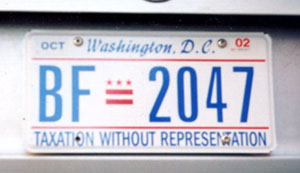Flat BF-Series Plates Evidence of DMV Problems
With respect to D.C. general-issue passenger license plates, the change from traditional embossed to new flat auto plates made with Digital License Plate (“DLP”) technology is evidenced in BG-series plates issued in late September 2001. There is, however, an exception. A small quantity of flat plates numbered in the BF series were issued in mid-October and quickly recalled, and their story is a good example of one way that multiple problems faced by the D.C. DMV at this time manifested themselves.
 Originally, registration numbers in the entire BF series were assigned sequentially on plates made with embossed characters. They were issued from sometime in July (probably late in the month) through early-to-mid September, when embossed plates in the BG series were introduced. On October 11 and 12, however, numbers BF-1901 through BF-2079 were issued again, this time on newly-made flat plates, duplicating 179* numbers already in use that had been issued about three months earlier.
Originally, registration numbers in the entire BF series were assigned sequentially on plates made with embossed characters. They were issued from sometime in July (probably late in the month) through early-to-mid September, when embossed plates in the BG series were introduced. On October 11 and 12, however, numbers BF-1901 through BF-2079 were issued again, this time on newly-made flat plates, duplicating 179* numbers already in use that had been issued about three months earlier.
The problem was identified in early November when some motorists to whom the duplicate numbers had been assigned began to receive citations generated by automated traffic enforcement equipment accompanied by photographs of vehicles that were not their own, but with their registration number. An attorney whose case was discussed in an early November Washington Post story described how he received an Oct. 26 photo of an early 1990s Toyota running a red light on North Capitol St. whereas he owned a brand new, 2002 Volkswagen. Plates on both vehicles displayed an identical registration number.
On November 7, DMV officials acknowledged the duplicate registrations having been issued, citing computer problems. A spokesperson said that she did not know what caused the malfunction, whether it could happen again, or whether it was related to the transfer of existing records to a new $17 million computer system, DESTINY, which went online in April 2002 (and that resulted in plate validation stickers being abandoned, in most cases, in favor of windshield stickers).
By the fall of 2001, maintaining the DMV's nearly 20-year-old computer system had apparently become a day-to-day exercise in futility. “It crashes constantly,” said Director Sheryl Hobbs Newman when interviewed by the Post after the duplicate plate number problem came to light, adding that she and her staff were “looking forward to the implementation of our new motor vehicle information system.” In a later story about a longer history of problems with duplicate numbers causing headaches for motorists and the DMV, the Post wrote “The DMV database that tracks vehicle registration and licenses has had a history of crashing on a nearly weekly basis and, in many instances, losing records. In some cases, registration records have become intermingled and confused.” It may have been one of these instances that led the DMV to determine (erroneously) in October that registrations BF-1901 through BF-2079 had never been issued, resulting in plates in the new flat style being made and distributed without the computer system rejecting the transactions.
The DMV reportedly mailed letters to affected motorists (presumably just those to whom the duplicate, flat plates were assigned on Oct. 11 and 12, but perhaps also users of embossed plates with the affected numbers if it was able to identify them), requesting that they exchange their plates for new ones on the morning of Wed., Nov. 14 at its satellite office on H St., NE (suggesting that perhaps that's the office that issued the duplicate numbers) or at the DMV's main office on C St., NW during regular business hours.
* The Post reported that “about 176 District motorists are driving around with the same license plate number as someone else…” When DMV officials discussed the problem with the Post, perhaps they indicated that even though there are 179 registration numbers between (and including) numbers BF-1901 through BF-2079, only 176 numbers were affected (i.e. valid).
|
This page last updated on December 31, 2017 |
 |
|
copyright 2006-2018 Eastern Seaboard Press Information and images on this Web site may not be copied or reproduced in any manner without consent of the owner. For information, send an e-mail to admin@DCplates.net |














